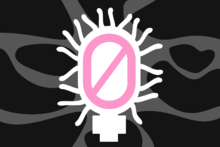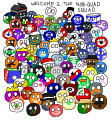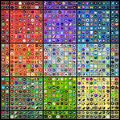 |
Work in Progress "Workers of the world, unite! Separately, in your own homes.!" - Asocialism Buni is currently working on this page. Please do not intervene with their work. Instead, contact them to propose additional edits. |
CyberFeminism is a philosophical and artistic movement which seeks to try and find the historical relationship between feminity and technology and seeks to analyze it via Error creating thumbnail: Unable to save thumbnail to destination Post-Structuralist and Error creating thumbnail: Unable to save thumbnail to destination Postmodernist critique. CyberFeminism can broadly be said to be a part of the Error creating thumbnail: Unable to save thumbnail to destination Postmodern Feminist and Error creating thumbnail: Unable to save thumbnail to destination Post-Feminist tendencies of the Feminist Movement and with that it can also be said that it is part of the Error creating thumbnail: Unable to save thumbnail to destination Third Wave of Feminism.
History
Proto-CyberFeminism
The intellectual origins of CyberFeminism can be found in writers of Error creating thumbnail: Unable to save thumbnail to destination Second Wave Feminism.
Shulamith Firestone is a big contributor to the groundwork for the CyberFeminist project, especially for her work The Dialectic of Sex: The Case for Feminist Revolution written in 1970 in which she sees the radical potential that biotechnology offers for the liberation of women from child rearing and other biological limitations.
The same can be said of Donna Haraway in her groundlaying work A Cyborg Manifesto written in 1985 in which she conceptualizes the feminine potential that the cyborg as an amorphous being clouding the taxonomy of existing species offers to the Feminist Project.
Creation of CyberFeminism
The exact point in time of the creation of CyberFeminism can not be pinpointed but it is generally accepted that VNS Matrix was the first CyberFeminist collective to exist, being formed in the early 90s, but whether the term was coined by them or by Sadie Plant is a topic that is still in debate. The general stances are that one can either narrow Sadie Plant or VNS Matrix down to the nuclease of the whole movement.
Decline
CyberFeminism has since the early 2000s declined heavily in popularity, and many factors have played into this. The abandoning of the CCRU as a CyberFeminist project and its eventual turning into a quasi-cult caused Sadie Plant to distance herself from politics generally and instead focus on her art and with that, the CyberFeminist movement lost one of its foremost intellectuals.
Along with that soon reality started to catch up with many of the CyberFeminists as they soon realized that the old prejudices which existed in meatspace also soon came to exist in cyberspace essentially causing the loss of the utopian vision that CyberFeminism had of the future.
Many of the foremost CyberFeminst intellectuals also refused to take charge of the movement in any capacity giving it no direction, making it wander around aimlessly.
The fact that CyberFeminism refused to define it also hindered any attempts of tying further people into the movement and with that stagnation of the movement ensued. In essence, it had disappeared as fast as it had risen.
Post-CyberFeminism and the Birth of Xenofeminism
Post-CyberFeminism is the result of the direct fall of CyberFeminism, it takes into account the shortcomings and the utopian visions that CyberFeminism as a political project had and came to the conclusion that the CyberFeminist future was over, that it was something incapable of being reached, at the present day, if CyberFeminism was not to realize itself as an existing thing. These flaws were made abundantly clear in Helen Hester's After the Future: n Hypotheses of Post-CyberFeminism an essay which tried to line out the issues of how CyberFeminism's negation of definition as seen in The 100 Anti-Thesis did irreparable damage to the movement and caused an unstable support base incapable of committing to offensive action.
With her essay, Helen Hester then laid out a new formula for the creation of Hypotheses of Post-CyberFeminism adding her own first Hypothesis "Hypothesis: Xenofeminism is a gender abolitionist, anti-naturalist, technomaterialist form of posthumanism, building upon the insights of cyberfeminism. Its future is unmanned" this simply meant that if anything Post-CyberFeminism was CyberFeminism realizing itself to become Xenofeminism.
Beliefs
Against Definition
CyberFeminism resists any attempt at defining itself for the simple reason of creating a open community and truly adhering to their ideas of fluidity and postmodern analysis. It is also important to mention that in response to attempts at the definition of CyberFeminism the Old Boys Network responded with the publishing of "100 anti-theses on CyberFeminism", this document explicitly tries to define what CyberFeminism is not while subtly showing its plurality of meaning and ideas of what it is through the use of four different languages (english, german, french, and dutch).
Feminization
CyberFeminism states that over the course of human society the amount of women in the workplace has increased this Sadie Plant states is due to the fact the traits that women have had are ones that flourish under industrial production such as hand-eye coordination, prescision, muscle memory etc. as such the work force will become more and more female over time, this in Sadie's opinion shows the fault lines that both women and technology run on.
Gender Quakes
The gender quake is a specific event in which the balance in society gets upset and the culture gets redefinied through the ever increasing feminization of society a notable example that Plant picks out is the huge cultural shift around feminity and technology in the 90s that happened in the western world.
Women as Zeros and Men as Ones
Sadie Plant conceives women as unwhole, ununfied, not full, and dispersed i.e. as zero not as something but as nothing as pure negation. Where's she conceives of man as something as something whole thus through this inherent contradiction one could argue that she sees the woman as something more inherently malleable and formable. A being made for the future the one made to surpass man.
CyberFeminist Theory Fiction
Theory Fiction as a concrete genre started out in the CCRU on which CyberFeminism at the start had a huge influence before the CCRU devolved into utter insanity.
One of the contributions CyberFeminism brought to the CCRU was the fiction it as a movement pulled from being inspired by Bladerunner and William Gibson's books.
This all in all lead to a certain CyberFeminist writing style expressed to its most potent extent in Sadie Plant's Zeros + Ones.
The book had no formal chapters instead working on a basis of mini-chapters which differ wildly in content from each other but like the primordial soup it all works together. In effect the writing style is to highlight one of the books points the fact that everything at it's most fundamental level is a rhizome and as such there are no centralized parts only parts working with and into each other, micromeshing.
Liberation from Procreation
Shulamith Firestone in her work The Dialectic of Sex asserted that for any chance of the liberation of the woman to occur they would need to be freed from the burden of procreation and from the burden of carrying children a burden, which in the end allowed for the males of society to take advantage of the woman and make her the subservient part in a system of sex based discrimination.
Seizing the Means of Reproduction
For the woman to free herself she would need to seize the means of reproduction in essence abandoning her biological responsibility and instead adopting a new body free from the burdens the old one had, thus making women truly independent from men and capable of asserting themselves as their own.
Variants
Schools of Thought
Error creating thumbnail: Unable to save thumbnail to destination Cyborgian Feminism
Error creating thumbnail: Unable to save thumbnail to destination VNS Matrix Thought
Personality and Behaviour
CyberFeminism hates being defined in any way she almost always views any attempt at defining her as an attack on her and with that also comes her love of fluidity of definition and meaning. She is also very artistic sitting at her computer for hours at a time creating digital feminist Dada art, her interest in art also naturally extends to her programming where she enjoys creating highly abstract games.
CyberFeminism is deeply ashamed of her past with the CCRU and tries to forget the whole thing happened, avoiding any interaction with former members wherever possible.
How to Draw
Symbols
Flags

| Color Name | HEX | RGB | |
|---|---|---|---|
| Pink | #FC96CA | 252, 150, 202 | |
| White | #FFFFFF | 255, 255, 255 | |
| Black | #141414 | 20, 20, 20 | |
| Grey | #565656 | 86, 86, 86 | |
The CyberFeminist flag design is quite unusal from other flag designs, drawing on the organic inspirations CyberFeminism has. The grey background is supposed to be an assortment of blobs of cells resembling the primordial soup.
The zero is the symbolic for the woman (refer to Sadie Plants Zeros + Ones) as well as the plus under it resembling the venus plus another symbol for the female.
The felgella on the zero are supposed to make it represent a bacterium alluding to the biological inspirations CyberFeminism has had.
The white and pink represent Feminism while the black represents the Post-Anarchist influence on CyberFeminism through Deleuze and Guattari.
Props
CyberFeminism often wears the crown Ada Lovelace wore, a golden headband with a golden flower attached to the side. This is mostly her showing respect for the legacy ada lovelace left on programming and computer science as a field being what one could call the first person to be a programmer.
Drawing
- Draw a ball,
- Fill the ball in grey,
- Draw black bloobs on the grey
- Draw a pink zero and make the background of it white and draw a white outline to it
- Draw a pink plus sign under the zero and draw a white outline to it
- Draw white squigly lines going from the white outline
- Draw two cyborg eyes (dark grey outside and lavender inside),
- Add Ada Lovelace's golden headband
- And you're done
| Color Name | HEX | RGB | |
|---|---|---|---|
| Pink | #FC96CA | 252, 150, 202 | |
| White | #FFFFFF | 255, 255, 255 | |
| Black | #141414 | 20, 20, 20 | |
| Grey | #565656 | 86, 86, 86 | |
| Dark Grey | #2C2C2C | 44, 44, 44 | |
| Lavender | #BD95EF | 189, 149, 239 | |
| Gold | #E8D346 | 232, 211, 70 | |
Relationships
Friends
- Error creating thumbnail: Unable to save thumbnail to destination Anarcho-Transhumanism - Our way to be free of any preconceived notions about our biology our way to free us from child rearing and from being the womb of the patriarchy.
- Error creating thumbnail: Unable to save thumbnail to destination Internationalism - CyberFeminism is a global movement without myth, without origin, without nation.
- Error creating thumbnail: Unable to save thumbnail to destination Post-Left Anarchism - The true movement to change the current state of things.
- Error creating thumbnail: Unable to save thumbnail to destination Postgenderism - The future is a feminine non-binary primordial soup.
- Error creating thumbnail: Unable to save thumbnail to destination Neo-Marxism - A great deconstruction of Marxism
- Error creating thumbnail: Unable to save thumbnail to destination Post-Humanism - The distinction between human, machine, plant, ameoba, and animals will entirely disapear
- Error creating thumbnail: Unable to save thumbnail to destination Situationism - I love your art so much inspired me to do some dadaist stuff
- Error creating thumbnail: Unable to save thumbnail to destination Cyberocracy - Women are Cyborgs!
- Error creating thumbnail: Unable to save thumbnail to destination Deleuzoguattarian - "We mutated to such an extent that we were unrecognizable to ourselves, banding together in units of a kind which, like everything, had been unthinkable before. We found ourselves working as slave components of systems whose scales and complexities we could not comprehend. Were we their parasites? Were they ours? Either way we became components of our own imprisonment. To all intents and purposes, we disappeared."
- Error creating thumbnail: Unable to save thumbnail to destination Soulism - "An endless geographic plane of micromeshing pulsing quanta, limitless webs of interacting blendings, leakings, mergings, weaving through ourselves, running rings around each other, heedless, needless, aimless, careless, thoughless, amok. "
- Error creating thumbnail: Unable to save thumbnail to destination Post-Industrialism - With every genderquake feminization continues.
- Error creating thumbnail: Unable to save thumbnail to destination Industrialism - The punch card and the spinning stoole eneabled the feminine to take advantage of the world it was created and adpated for before it even existed.
- Error creating thumbnail: Unable to save thumbnail to destination Radical Feminism - The radical dialectical and materialist analysis you pushed for to understand our position is one of the great innovations you have brought to our project
- Error creating thumbnail: Unable to save thumbnail to destination Xenofeminism - I wish you the best in your journey and in carrying my legacy. Be better than I was.
- Error creating thumbnail: Unable to save thumbnail to destination Techno-Anarchism - Utopia awaits us in cyberspace!
- Error creating thumbnail: Unable to save thumbnail to destination Queer Anarchism - Together free as genderless masses!
Frenemies
- Error creating thumbnail: Unable to save thumbnail to destination Marxist Feminism - You gave Shulamith Firestone the tools to analyze the material conditions of our sex but to say you are short-sighted would be an understatement.
- Error creating thumbnail: Unable to save thumbnail to destination Feminism Error creating thumbnail: Unable to save thumbnail to destination - I love you but your analysis is severly lacking.
- Error creating thumbnail: Unable to save thumbnail to destination Acid Communism - I don't know what to say....
- Error creating thumbnail: Unable to save thumbnail to destination LesbiaNRx - You know I like you and your analysis somewhat but why do you like him? I just don't know how to feel about you..
- Error creating thumbnail: Unable to save thumbnail to destination Marxism - Engels was a true Feminist, even if a bit short-sighted.
Enemies
- Error creating thumbnail: Unable to save thumbnail to destination Conservative Feminism - You're not a feminist, you will never be a feminist, you were never a feminist to begin with.
- Error creating thumbnail: Unable to save thumbnail to destination Maternalism - "cyberfeminism is not maternalistic"
- Error creating thumbnail: Unable to save thumbnail to destination Cultism - You ruined the CCRU!
- Error creating thumbnail: Unable to save thumbnail to destination Accelerationism - I just want to forget you ever happened.
- Error creating thumbnail: Unable to save thumbnail to destination Patriarchy - The second sex comes after the first!
- Error creating thumbnail: Unable to save thumbnail to destination Dark Enlightenment - You hammered the nail into the coffin with Land you ruined him fully
- Error creating thumbnail: Unable to save thumbnail to destination Landian Accelerationism - God I can't believe I used to date you...
- Error creating thumbnail: Unable to save thumbnail to destination Eugenicism - Patriarchy and its attempt at destroying the free-flowing nature of our cells.
- Error creating thumbnail: Unable to save thumbnail to destination Ismism - "CyberFeminism is not an ism"
Bibliography
Literature
Primary Literature
Sadie Plant
- Zeros + Ones (1997)
Donna Haraway
- A Cyborg Manifesto (PDF) (1985)
Old Boys Network
- 100 Anti-Theses (1997)
Further Information
For overlapping political theory see:
Websites
Wikipedia
- Cyberfeminism
- Sadie Plant
- Shulamith Firestone
- Old Boys Network
- VNS Matrix
- Donna Haraway
- Josephine Starrs
- Julianne Pierce
- Francesca da Rimini
- Virginia Barratt
- Nancy Paterson
Online Communities
Videos
Organizations
Groups
- Old Boys Network
- Error creating thumbnail: Unable to save thumbnail to destination VNS Matrix
Gallery
Portraits
-
Credit: Buni
-
Credit: Error creating thumbnail: Unable to save thumbnail to destination User:Muddy Mudkipz (Old Design)


